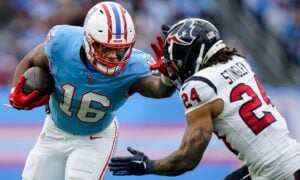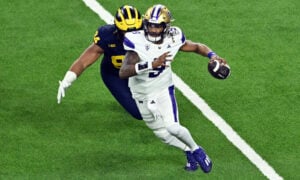Building through the Rookie Draft: A Case Study, Part One
The fantasy playoffs are just around the corner for a lot of teams and hopefully your teams are among them! However, for about half of the dynasty teams out there, this is the time of year when you really start to focus on next year. For most of us, that means you start watching a bit more football on Saturday, you start pouring over the early mock drafts, and you hopefully start making more use of all of the devy and scouts articles on DLF. After all, the best way to improve your team is through the draft.
Or at least that is what everyone seems to think, but is that really the truth?
Over my decade of doing dynasty leagues, I’ve gone back and forth on draft picks. At times I have valued them above all else, while at other times I have been one of the first owners to sell off my picks for current assets. Typically it is the state of my team which has been the deciding factor for me, but I’ve recently been wondering if there is an absolute answer that should be followed almost all the time. Kind of like the wave of analytics that has been taking over professional sports and challenging traditional wisdom. I don’t know if I’ve fully discovered the answer, but I wanted to do a little investigation to see what I could figure out.
For this look, I went back through the 2013-2017 draft classes. I examined the first two rounds of players according to their rookie draft ADP at the time. For each of the first 24 players in each draft class I assigned them to one of the following category:
Stud: The name says it all. These players are the cream of the crop and what we hope every draft pick will become when we make those picks. These players are top 10 if not top 5 at their position multiple years in a row.
Starter: While these players might not be the best of the best, they are still likely to be an every week starter on most fantasy teams. For this examination, they needed to be at this level for multiple years.
Backup: These players are definitely on rosters, but they are nothing more than a spot starter, flex play, or an injury fill in. In a few cases they are players who have had one good year, but they haven’t been consistent enough to be counted upon.
Bust: Many of these players are out of the league. If they are still in the league, they have shown so little that they are often on the waiver wire or barely hanging on to the end of the bench spots in leagues.
As you would expect, the more recent classes have a lot more players in the middle of the spectrum while classes like the 2013 draft class are much more towards the end. Here is the breakdown of the draft classes. There might be some debate about where I placed a few players as there is a bit of subjectivity, but you will get the overall impression.
[am4show have=’g1;’ guest_error=’sub_message’ user_error=’sub_message’ ]
2013 Draft Class (ADP in rookie drafts)
Studs: 5 total – Le’Veon Bell (1.05), DeAndre Hopkins (1.06), Keenan Allen (2.02), Zach Ertz (2.09), Travis Kelce (2.10)
Starters: 1 total – Robert Woods (2.01)
Backups: 2 total – Eddie Lacy (1.01) and Giovani Bernard (1.03)
Busts: 16 total – Includes Tavon Austin (1.02), Montee Ball (1.04), Cordarrelle Patterson (1.07), Tyler Eifert (1.08), Johnathan Franklin (1.09), Marcus Lattimore (1.10) and others.
Hardest Call: Lacy – He was an every week starter for the first few years, but is now out of the league. You can’t fully ignore those few years and call him a bust, so I gave him a little credit.
2014 Draft Class
Studs: 3 total – Mike Evans (1.02), Odell Beckham Jr (1.04), and Davante Adams (1.07)
Starters: 3 total – Brandin Cooks (1.03), Allen Robinson (1.09), Devonta Freeman (2.08)
Backups: 10 total – Includes Sammy Watkins (1.01), Eric Ebron (1.05), Jordan Matthews (1.06), and Marqise Lee (1.08)
Busts: 8 total – Includes Bishop Sankey (1.10), Cody Latimer (2.02), Tre Mason (2.03)
Hardest Call: Freeman – He had two elite years, but the injuries have really started to pile up. He is right on the fringe of being a stud.
2015 Draft Class
Studs: 2 total – Todd Gurley (1.01) and Melvin Gordon (1.03)
Starters: 4 total – Amari Cooper (1.02), Tevin Coleman (1.11), David Johnson (2.02), Marcus Mariota (2.07)
Backups: 8 total – DeVante Parker (1.04), Nelson Agholor (1.06), TJ Yeldon (1.10), Devin Funchess (1.12), Jameis Winston (2.04), Duke Johnson (2.06), Tyler Lockett (2.09), Jay Ajayi (2.10)
Busts: 10 total – Includes Kevin White (1.05), Ameer Abdullah (1.07), Dorial Green-Beckham (1.08), Breshad Perriman (1.09), Phillip Dorsett (2.01)
Hardest Call: Cooper – I think he is going to turn into a stud, but so far he’s just produced at a fringe WR1 level which earns him a designation as a starter.
2016 Draft Class
Studs: 4 total – Ezekiel Elliott (1.01), Michael Thomas (1.07), Jared Goff (2.07) and Carson Wentz (2.11)
Starters: 1 total – Jordan Howard (2.02)
Backups: 7 total – Josh Doctson (1.04), Sterling Shepard (1.05), Derrick Henry (1.06), Tyler Boyd (1.08), Hunter Henry (2.04), Kenyan Drake (2.05), Alex Collins (2.12)
Busts: 12 total – Including Laquon Treadwell (1.02), Corey Coleman (1.03), CJ Prosise (1.09), Leonte Carroo (1.10), Kenneth Dixon (1.11) and Will Fuller (1.12)
Hardest Call: Goff and Wentz – Both have had moments of brilliance, but if they are going to take over the throne from players like Tom Brady and Drew Brees they have to string together a few more years.
2017 Draft Class
Studs: 4 total – Christian McCaffrey (1.03), JuJu Smith-Schuster (1.09), Alvin Kamara (1.12), Kareem Hunt (2.02)
Starters: 6 total – Corey Davis (1.01), Leonard Fournette (1.02), Joe Mixon (1.04), Dalvin Cook (1.06), OJ Howard (1.07), Evan Engram (1.10)
Backups: 7 total – Mike Williams (1.05), John Ross (1.08), David Njoku (1.11), Zay Jones (2.04), Chris Godwin (2.05), Marlon Mack (2.07), Taywan Taylor (2.11)
Busts: 7 total – Curtis Samuel (2.01), Samaje Perine (2.03), D’Onta Foreman (2.06), Wayne Gallman (2.08), Carlos Henderson (2.09), Joe Williams (2.10), Jeremy McNichols (2.12)
Hardest Call: Whole Draft Class – For players who are only in the middle of their second season it is really difficult to classify and forecast their careers. Some players just take longer to figure out the NFL while others start hot and fizzle, so the book is far from closes on this group.
Overall 2013 through 2017
Total: 120 draft picks
Studs: 18 players or 15 percent
Starters: 15 players or 12.5 percent
Backups: 34 players or 28.3 percent
Busts: 53 players or 44.2 percent
This means we are looking at just a little bit over a quarter of the draft picks who turn into someone you can start on a regular basis. When you add in the fact that the 2017 draft class has several players I optimistically labeled as starters who might turn into less than that within the next year or two, we are probably looking at a little bit under a fourth of all draft picks ending as “hits.”
Some draft classes are definitely better than others. The 2014 draft class definitely stands out with only one bust in the first 13 picks to go along with the best hit rate aside from the uncertainty of the 2017 class. However, even that class doesn’t really exceed the 25% hit rate (studs plus starters). It just has a lot more of the “backup” caliber of player instead of outright busts.
I always thought the hit rate on draft picks was about 50/50, but it seems to be consistently right around 25 percent, making me think using draft picks as trade bait instead of actually drafting might be the better plan. However, that is just an early look at the data. Come back for the future parts as I break this hit rate down a little bit more by position and draft position to see if we can come up with any deeper patterns and trends to help make a more informed decision.
[/am4show]
- Final 2021 Pre-Draft Rookie Mock: Round Three - April 28, 2021
- Final 2021 Pre-Draft Rookie Mock: Round Two - April 26, 2021
- Final 2021 Pre-Draft Rookie Mock: Round One - April 25, 2021


































































